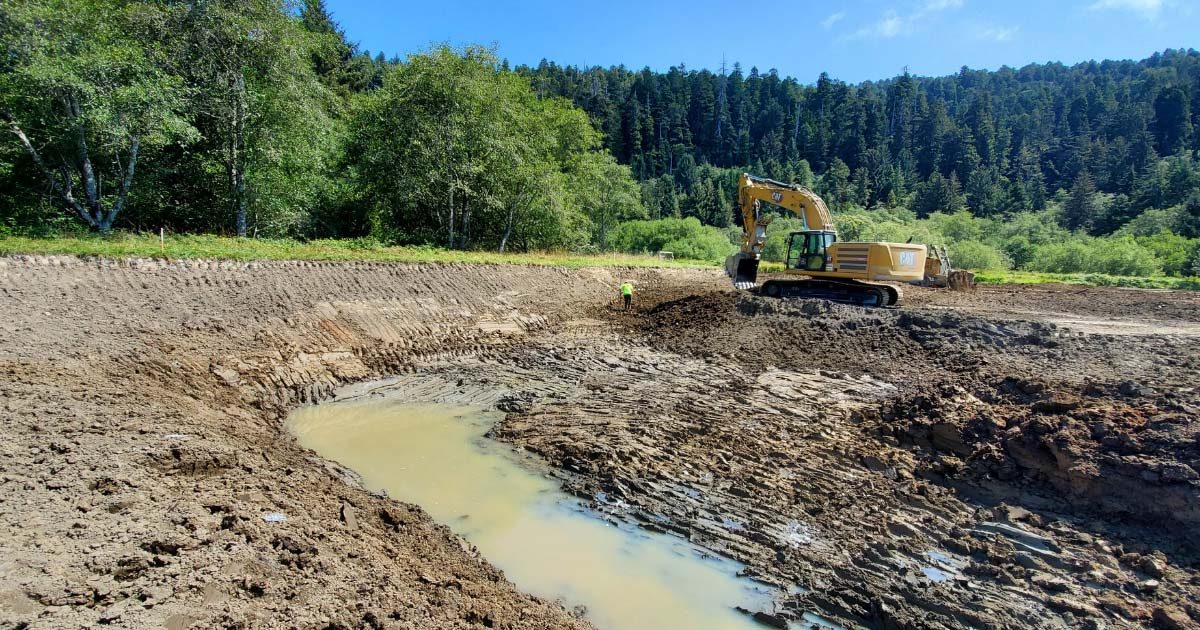Prairie Creek Floodplain Restoration Enters Second Phase of Construction
Along the banks of Prairie Creek in Humboldt County, the last wisp of fog gives way to a bright blue sky revealing a busy construction site below ancient redwoods. This summer marks the second year of construction by the Yurok Tribe on a large collaborative project that is transforming a developed and degraded site into the southern gateway to Redwood National and State Parks.
In 2022, the Prairie Creek Floodplain Restoration Project began a two year phase to restore 11 acres of riparian habitat, create 800 feet of a new creek channel, and construct a second backwater pond to provide slow water refugia for juvenile salmon and steelhead. Today, the creek is constrained against the asphalt of Highway 101. This work will move the creek allowing it to meander and connect to a restored floodplain with a richness of native plants as the basis for the nutrient-rich food web.
Prairie Creek is and has been a home to many. It is the ancestral and unceded homelands of the Yurok Tribe. Over the years, it has been occupied by fishers, hunters, ranchers, loggers, and mills. And in its waters swim Chinook and coho salmon, steelhead, coastal cutthroat trout, eulachon, and lamprey. Prairie Creek provides critical habitat for these fish species, and the restoration project elevates the habitat in this property to be a part of the stronghold upstream that is managed by Redwood National and State Parks.
But the full vision for this property is not just for fish. In 2025, upon completion of the full five years of construction, the site will provide a new point of public access – the southern gateway to Redwood National and State Parks system. To achieve the full project, soil excavated from the floodplain is being used as fill where the mill site asphalt is removed, creating the foundation for visitor amenities and trails that will connect the site with the surrounding parks.
The first phase of restoration work was completed at Prairie Creek in 2021, including the construction of two acres of a backwater pond and riparian floodplain habitat for juvenile salmonids – funded by NOAA and California State Coastal Conservancy. To learn more about the first phase, watch our video at this link or below.
The 2022 – 2023 construction seasons are funded through grants from the California Ocean Protection Council and California Wildlife Conservation Board and through a donation by Save the Redwoods League. The grants are being administered by California State Coastal Conservancy. CalTrout is proud to be a part of the leadership team for this project – we support our team of local experts in engineering (Northern Hydrology and Engineering & SHN), revegetation (McBain Associates and Redwood Coast Action Agency), environmental compliance (GHD), and the Yurok Tribe construction team made up of the Yurok Tribe Construction Corporation and Fisheries Department. We are at the table with the landowner and project champion, Save the Redwoods League, the CA State Coastal Conservancy, and the full set of project partners and funders who are planting the seed for this interconnected future at Prairie Creek.
Watch our Video:
Learn More:
Learn more about CalTrout’s work at Prairie Creek and in the North Coast.
Cover Photo Credit: Mike Malone





